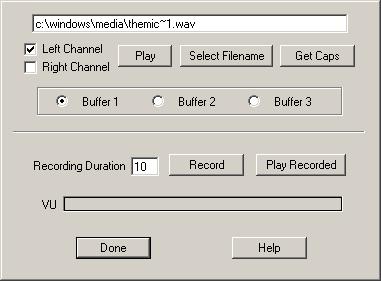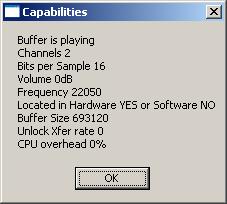

In this dialog you are presented with three sound buffers, each buffer can have a single WAVE file in it, can be played out the Left or Right or Both channels and you can get the capabilities and info on that buffer. These three buffers will be used in the later tests that probe the interaction between keeping synch with the vertical retrace and playing sound. Once a buffer has been played switching to that buffer will play it again, this is to ease playing multiple files at once to test the mixing of buffers.
With the addition of DMDX's ability to record subject vocal responsesaudioinput@dmdxh.hlp and to also become a digital VOX this dialog has been extended to allow you to record from the default audio input device for a specified number of seconds. As data is being recorded the VU meter shows current signal strength. Once recorded pressing the Play Recorded button transfers the recorded data into the current sound buffer. If the message "WARNING: No Data Received" appears then it is unlikely that the audio card in your machine is capable of the full duplex operation required for use with DMDX. The only other thing possible is that the sound card is somehow improperly configured. If you get no warning message and still no VU activity then it is likely that the windows mixer record properties have not been set correctly (if you are using a MIC for input it should be selected and it's input level set, if the LINE IN is used it should be selected).
As a general note, DMDX (and therefore TimeDX) will always create primary buffers played at 22050 16 bit samples per second, any other WAVE PCM file format will be converted to that format on the fly by DirectX. Meaning that there is extra work to be performed and therefore probably a higher chance of loosing sync. with
the retrace if the data rate and format are different, if you intend to use non 16 bit 22.050 kHz files you might want to check that the Vertical Retrace Sync Thread and Tachistoscopic Acid Test tests function correctly.
The capabilities have a few unusual fields that need to be
explained:

Volume of 0dB means the output will be un-attenuated, +ve would be amplified (currently unsupported by DirectX), -ve attenuated, this is included because I needed it for debugging purposes, it should always be 0dB.
The buffer size is in bytes, not samples.
Located in Hardware refers to some sound cards that have
their own memory on them, usually wave table cards. If there is a card with these capabilities and there is is sufficient memory on the sound card the sound will be stored there with the net result that playing the sounds presents an even lower load on the CPU.
The CPU overhead is the percentage of total CPU ability used to play (and mix) that channel. All I've ever seen here is 0% so I suspect sound as a rule is not really posing much of a problem -- either that or the field is bogus, a possibility as it may be provided for future use.
The Unlock Xfer rate is the rate at which the sound would be transferred to the sound card prior to it's being played if the channel was located in hardware, something we don't care about because DMDX will always read the audio data before the item begins.
TimeDX Index.